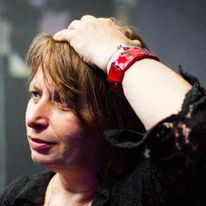 I sat down with Jo Truman, a multimedia artist living in Wentworth Falls to discuss her life journey as an artist working with sound, musical composition, voice and the visual arts. While most of her works involve sound and musical compositions, she is also an accomplished visual artist as this watercolour, gouache and graphite image of a broken magpie attests.
I sat down with Jo Truman, a multimedia artist living in Wentworth Falls to discuss her life journey as an artist working with sound, musical composition, voice and the visual arts. While most of her works involve sound and musical compositions, she is also an accomplished visual artist as this watercolour, gouache and graphite image of a broken magpie attests.
In particular we explored a multimedia work of sound and voices she created, inspired by the Blue Mountains—Bridge to Otherness.
Studies
Jo has long been interested in the power of sound, of music and vibrational forces, as well as the visual arts. This saw her undertake a BA in Communications at UTS, followed by a Masters of Music at the Sydney Conservatorium, University of Sydney. Currently Jo is enrolled in a Doctorate program with Western Sydney University exploring the role of the body as a musical score, the holder of imprinted stories through processes of internal perception. For this work she is exploring the neurobiology polyvagal theory of how trauma is held and experienced in the body through the flight, fight, freeze process of dealing with emotions, as she explores her own childhood experiences.Bridge to Otherness—A Portrait in Sound
When the Bicentenary of the Crossing of the Blue Mountains by the colonial explorers, Blaxland, Lawson and Wentworth was being commemorated in 2013, Jo was inspired to produce a multi-media work for radio, Bridge to Otherness. Jo pitched the idea to producer Mathius Heuger from West German Radio (Westdeutschr Rundfunk, Audio Akustisches Kunst) as a contemporary horspiel work. This tradition now informs the modern popularity of podcasting. Jo says she was interested in exploring how we navigate ‘Self/Otherness/Place’ in exploring the meaning of the Great Western Highway in its historical context, and also its role in the marginalisation of the traditional people of the Blue Mountains. These are the Dharug people whose land stretches from Parramatta to Dargan near Lithgow, and the Gundungurra people whose land stretches from the Southern Highlands through Lake Burragorang (Warragamba Dam) to all the land that lies along the southern side of the Great Western Highway, from Glenbrook to the Megalong.
Mathius Heuger was interested in Jo’s idea and commissioned her to write a work that would be a profile in sound of the Blue Mountains combining singing, spoken voice and music. Jo says she deliberately did not want to produce a work that celebrated colonial conquest.
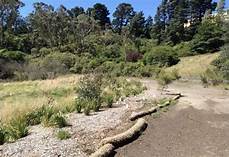 Gardjari—The Gully
Gardjari—The Gully
She wanted to particularly explore the sense of loss experienced by the Gundungurra and Dharug people who had lived in an Aboriginal camp in the Gully, a natural amphitheatre centred on a hanging swamp that comprises the headwaters of the Katoomba Falls (Kedumba) Creek, which lies close to Katoomba town centre.
As Jo notes in her own research for Bridge to Otherness, farming in the Megalong Valley and the flooding of the Burragarang, creating the Warragamba dam to supply water for Sydney, forced many Gundungurra and Dharug people to settle permanently in the Gully. A refuge for the poor-both Aboriginal and non-Aboriginal who struggled to participate in the local economy of the township of Katoomba. But their relatively peaceful coexistance was to be shattered in the early 1950’s when their outsiders status was deemed by local and council to deny them of any rights. A racetrack was proposed to tear their community apart, disperse family and friends far and wide and degrade the rich ecology of Gadjari into a place of spectator sport for entertainment. The people were given a week to leave in 1957 and find other places to live, splintering their community.
Following a sustained campaign, in 2002, through the work of the Garguree Swampcare project, the Gully was declared an Official Aboriginal Place. The Swampcare Group brought together the Gully Traditional Owners and the Blue Mountains community to help and restore the natural habitat of the area. The Gully is now co-managed by the traditional owners and Council. Therefore the first people Jo interviewed were Aunty Sharon Brown and Uncle Ted, Gundungurra Elders who were closely involved in the history of the Gully and the struggle of Gundungurra and Dharug people to regain possession of this important cultural site. Slowly the last vestiges of the racetrack are being reclaimed by nature, and under the leadership of Dharug man, David King, a community group now takes care of this special ngurra.Planetary Health Exhibit
A recent exhibition, Critical Mass: The Art of Planetary Health at the Blue Mountains City Art Gallery features the Bunburang Walkers Trail between 2013-1015 under the auspices of the Gundungurra Heritage Association project, Bunburang Maroodang (Mountain Dragon walking along the track). This was led by Aunty Sharyn and archaeologist, Michael Jackson, leading groups of people to follow Gundungurra Ancestral Pathways through the southern part of the Blue Mountains. In the words of the exhibit, it pays homage to Ngurra (country) in the life of the Gundungurra people.[vc_column_text css=”.vc_custom_1613703091020{margin-top: 7% !important;margin-right: 7% !important;margin-bottom: 7% !important;margin-left: 7% !important;padding-top: 5% !important;padding-right: 5% !important;padding-bottom: 5% !important;padding-left: 5% !important;background-color: #eae2c2 !important;}”]”Ngurra’ includes everything connected to the cultural and spiritual landscape—landforms, water, air, trees, rocks, plants, animals, foods, medicine, minerals, stories and significant places. It includes cultural practices, knowledge, songs, stories and art, as well as Spiritual beings and people, present and future. Ngurra has a deep meaning of belonging.”[vc_column_text css=”.vc_custom_1613702835316{margin-top: 0% !important;margin-right: 0% !important;margin-bottom: 0% !important;margin-left: 0% !important;padding-top: 5% !important;padding-right: 5% !important;padding-bottom: 5% !important;padding-left: 5% !important;background-color: #ddd0ba !important;}”]Contributors
Bridge to Otherness as a portrait in sound, which was conceived and produced by Jo, was mixed and edited at Sound Heaven studios by John Stuart, who as Jo acknowledges went beyond and above in terms of support. People interviewed as part of telling the story of Bridge to Otherness include residents of the Blue Mountains such as the anthropologist Ute Ecklekamp, the writer Carol Major, local ecologists and environmentalists Andy McQueen and Wyn Jones, author Rev Eugene Stockton, Mark Alchin, the owner of Leura’s Wayzgoose Café, and one of his patrons, John Hockney, raconteur and brother of Britain’s famous artist, David Hockney. To complete the picture, Jo also interviewed a manager of the Great Western Highway upgrade that was being undertaken. This portrait in sound also included poetry from Hugh Spears who also acts as narrator, and Weizen Ho singing and playing improvised piano.
This portrait in sound also included the following words by Jo:
“This corridor we have built we take for granted, created for our convenience. It allows us to move from one point to another, unimpeded. It allows the movement of goods and food, and coal, gouged from the grounds in the western plains beyond the Mts, to be transported to the coast to a destination where its energies, compressed by aeons, will be released to be consumed by us. But the corridor we know, has been here for a mere scratch in time, compared to wilderness which is millions of years old.”
Some of the other ideas that informed Jo’s work include the contrast between the soundscapes and timescapes of suburbia and wilderness. What is its meaning on multiple levels? Its historic importance of opening up the ‘otherness’ of Wiradjuri country, the western plains, to colonial settlement, and the displacement of Indigenous people as their traditional lands were taken and given as grants to whitefella colonialists—resulting in the ‘Bathurst Wars’? Jo also saw it as a bridge to the otherness of soundscapes—the mechanical and industrial noises of suburbia contrasting and conflicting with the organic sounds of the wilderness of the Blue Mountains National Park; the changes in the sense of time, from the slowness of deep time and early colonial life to the fast time of modern society, with the widening of the highway for increased traffic of trucks and cars, and how this affects our experience and perception of place.
As Jo says, if we think about time, the deep time of Aboriginal cultures is non-linear, connected to the seasonal cycles of local ecologies and the ancient songlines of Indigenous knowledge systems.[vc_column_text css=”.vc_custom_1613702773597{margin-top: 7% !important;margin-right: 7% !important;margin-bottom: 7% !important;margin-left: 7% !important;padding-top: 5% !important;padding-right: 5% !important;padding-bottom: 5% !important;padding-left: 5% !important;background-color: #ead9be !important;}”]Jo: “Time in modern society is all about getting from A to B in as short a time as possible. We call that efficiency. It doesn’t allow for peripheral vision, taking in the world around us. It’s like narrowscope versus widescope in our sense of awareness. So I was interested in these different modalities in how we relate to our world, as we modern people are caught up in ‘rushing through’, becoming impatient with traffic jams; just wanting to ‘get there’, rather than ‘be’ in the world around us. I could see how destructive this modern construction of time has been for us, and how since colonial times it has all been tied up in the idea of continual progress.”What has this progress meant? Getting more and more from the land, whether in mining or agriculture as technological productivity, while at the same time destroying the natural productivity and fecundity of the land, which has been the focus of Aboriginal relationship to caring for country for millennia. Today we look at the devastation such ‘progress and productivity’ has wrought on country—raging bushfires, prolonged drought, soil loss, drying rivers and mass fish kills and widespread species extinctions, while on a social level we look into the face of an epidemic of loneliness, anxiety and depression in a world mediated by the clickbait of social media algorithms.
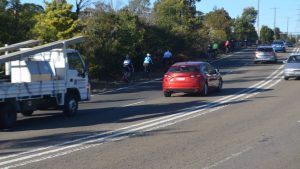 As Jo says, along with a sense of a changing timescape there is a changing soundscape that matches this. Modern society drowns out the sounds of the natural world and the various meanings they impart. For Aboriginal people, the sounds of the birds and insects carried meaning about the changing fecundity of nature to support an ongoing food supply. From an early age, Aboriginal people learn to intimately read the landscape through sounds connected to a web of visual signs.
As Jo says, along with a sense of a changing timescape there is a changing soundscape that matches this. Modern society drowns out the sounds of the natural world and the various meanings they impart. For Aboriginal people, the sounds of the birds and insects carried meaning about the changing fecundity of nature to support an ongoing food supply. From an early age, Aboriginal people learn to intimately read the landscape through sounds connected to a web of visual signs.
The Great Western Highway encapsulates all these themes as it carves a ribbon of bitumen through country, via cuttings into the rockface and bridges over precarious drops. This carving out of the road across the rugged cliffs and escarpments of the Blue Mountains plateau went from the ancient tracks and pathways of the Dharug and Gundungurra people, connected to sacred sites and songlines, to a single lane road for horses and bullock trains, to a bitumen highway for cars and modern trucks, partnered with a railway line, and now to a four-lane highway gradually extending from the M4 freeway of Sydney across the entire Blue Mountains system.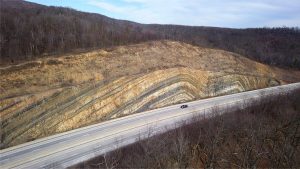 [vc_column_text css=”.vc_custom_1613702896049{margin-top: 7% !important;margin-right: 7% !important;margin-bottom: 7% !important;margin-left: 7% !important;padding-top: 5% !important;padding-right: 5% !important;padding-bottom: 5% !important;padding-left: 5% !important;background-color: #e5c8a9 !important;}”]”A country of so singular a description could in my opinion only have been produced by some Mighty convulsion in Nature – Those immense unconnected perpendicular Masses of Mountain which are to be seen towards its Eastern Extremity towering above the Country around, seem to indicate that the whole of this tract has been formed out of the Materials of the primitive mountains of which these masses are the only parts that have withstood the violence of the concussion.”
[vc_column_text css=”.vc_custom_1613702896049{margin-top: 7% !important;margin-right: 7% !important;margin-bottom: 7% !important;margin-left: 7% !important;padding-top: 5% !important;padding-right: 5% !important;padding-bottom: 5% !important;padding-left: 5% !important;background-color: #e5c8a9 !important;}”]”A country of so singular a description could in my opinion only have been produced by some Mighty convulsion in Nature – Those immense unconnected perpendicular Masses of Mountain which are to be seen towards its Eastern Extremity towering above the Country around, seem to indicate that the whole of this tract has been formed out of the Materials of the primitive mountains of which these masses are the only parts that have withstood the violence of the concussion.”
William Wentworth—Explorer
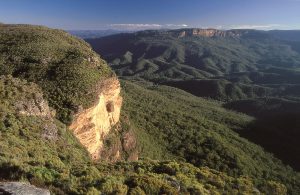
Blue Mountains National Park
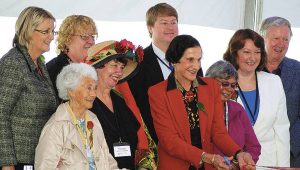 Talking with Jo, and reviewing the press clips, I realised that when you look at all the celebrations that occurred for the 2013 bicentenary, it was almost a completely ‘whitefella’ celebration of colonial conquest, although we do see two of the Aboriginal Elders in this photo, doing their best to represent their people.
Talking with Jo, and reviewing the press clips, I realised that when you look at all the celebrations that occurred for the 2013 bicentenary, it was almost a completely ‘whitefella’ celebration of colonial conquest, although we do see two of the Aboriginal Elders in this photo, doing their best to represent their people.
However, reading the publicity, there seemed little sensitivity to what this meant for the Dharug, Gundungurra and Wiradjuri people: that the triumphs of colonial conquest of nature meant for them immeasurable loss—of dispossession, brutal frontier wars, denial of their culture and its laws, deliberate annihilation of their languages. Despite all this, Aboriginal people have hung on to their cultural heritage, nurtured by the depth and strength of their connection to country.
Australia is still coming to terms with this history in the relationship between First Nations peoples, who comprise but 3% of the population but have a continual cultural relationship with this land for over 60,000 years, and non-Indigenous Australians, of whom over 53% are from an Anglo-Celtic cultural background, the world of the white colonial settlers who shaped modern Australia, its laws and institutions. The coming to terms with our history is currently playing out in the national response to the 2017 Uluru Statement from the Heart, which is calling for Voice, Treaty and Truth as a way forward for us all to walk together—including a change to Australia’s Constitution to include an Indigenous Voice to Parliament to be enshrined in the Constitution.Other Recent Works
Jo Truman’s other recent works include:
Dream Slash Nightmare—her structured improvisation first performed at MONA FOMA with Lennie Marks and Daniel Grinvalds, along with another work ‘Elements” for the Morning Meditations series at St Marys Cuppola which was composed around the theme of Earth, Fire, Air and Water with Lennie Marks and Daniel Grinvalds. https://www.youtube.com/watch?v=TndFLAsyO2o
Sydney Fringe Festival—improvised work with John Shand, Tim Cunningham and Andrew Milne
Water Babies, an opera for children and adults, working with composer Freddie Hill. Rehearsed with Kindle Hill School, ‘Water Babies’ was performed at the Seymour Centre (2016), Kindle Hill (2017) and ACA Theatre Leichardt (2019) (http://thewaterbabies.com.au).
This is a Voice—2018 series of 30 min performances at the Powerhouse Museum Concert series and 6 performances at ‘The Void’ at MONA in Hobart, Tasmania—working with Freddie Hill, Paul Herron, and Brad Madigan. Here is a link to one of her improvisation works: https://www.facebook.com/jo.truman/videos/10158571130343648
Traversing the Void—Libretto for Icelandic Opera—Jo received an Australia Council grant to write a libretto for a collaborative project with Icelandic composer Hildigunnar Runnarsdottir’s kammer opera, will have its world premier in Rejjkavic at the Reyjkavic chamber Music Festival. The Runnarsdottir/Truman chamber work will be performed by the Cameratica Quartet on November 8, 2020 in Iceland, with libretto sung by Helgi Runnarsdottir.

![Call of the Dakini | A Memoir of a Life Lived [Extract]](https://regenesis.org.au/wp-content/uploads/2023/08/Catalogue-OF-Articles-by-Barbara-Lepani-July-2018-July-2023-.jpg)
Recent Comments